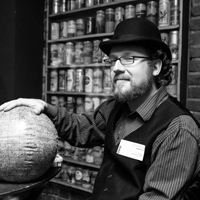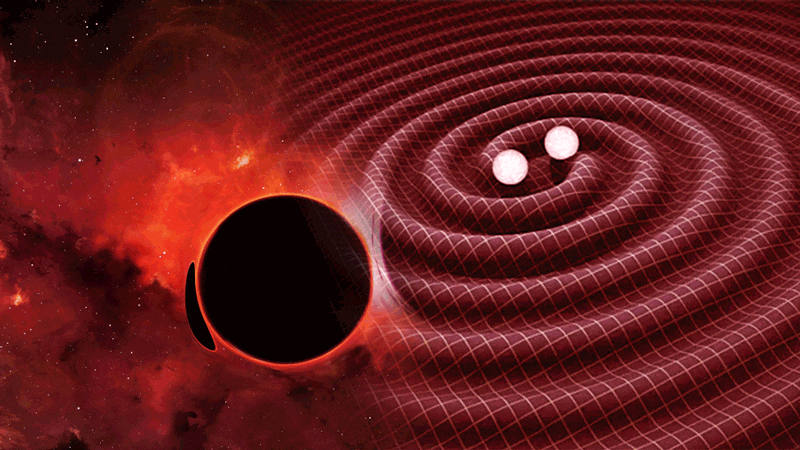In Madeleine L’Engle’s classic novel A Wrinkle in Time, the characters travel from one place to another in space using a hidden fifth dimension, which they use to “wrinkle” the fabric of space and time. In the book and upcoming movie, this travel is more mystical than it is science. However, some scientists think there might be extra dimensions beyond the four (three space plus one time) that we’re familiar with—and those dimensions might affect the way gravity works.
But how can we know for sure? One way to check uses the collision of two neutron stars, as detected by the gravitational wave observatories LIGO and Virgo in 2017.
While they found no sign of a fifth (or sixth or seventh or…) dimension, researchers—who recently posted their work on the website arXiv—were excited.
That’s because looking for extra dimensions is difficult. We only see three dimensions in space (length, width, and depth) and one in time on the scale of the everyday; if a fifth dimension exists, it has to be hiding from us. That pushes any detectable consequence into the realm of the very small—the regime of particle physics and string theory—or the very large, where LIGO and other astronomical measurements come in.
“It’s just really cool that we’re able to make that measurement in the first place,” Kris Pardo, a physicist at Princeton University who was the lead author on the study, told The Daily Beast.
“We know the universe is expanding, and it’s expanding at an accelerated rate,” Pardo said. That acceleration is something we call “dark energy,” for lack of a better term. “We’re not sure why it’s doing that.”
Some physicists have proposed that maybe the universe has one or more extra dimensions that show up on very large scales, making the universe accelerate. In these theories, light and matter are confined to the four dimensions we know, but gravity “leaks” into the other dimensions. As a result, gravity gets a little weaker the farther out in space we look, but light shouldn’t be affected by the extra dimensions.
The problem is that it’s hard to test gravity on very large scales. However, gravity makes gravitational waves: ripples in spacetime that travel at the speed of light. LIGO and Virgo detected gravitational waves from two colliding neutron stars about 130 million light-years away, which by itself is very exciting. But other observatories also saw light from that collision, which means astronomers have two very different ways to study the same event.
“For the first time ever, we’re seeing gravitational waves and light emitted from the same source,” said Maya Fishbach of the University of Chicago, who is part of the LIGO collaboration, said.
If the universe has extra dimensions for gravity to leak into, the gravitational wave signal from the colliding neutron stars would be weakened. That in turn would make the source look like it was farther away, just like a faint light could be a dim flashlight or a brighter light farther off. The brightness of the light signal and the strength of the gravitational wave signal are independent ways to measure how far away the colliding neutron stars were.
“The light and gravitational waves are traveling from the same source together,” Fishbach explained. “We can measure the distance from the gravitational waves, and it matches the distance from the light.”
In fact, the match between the light and the gravitational waves was astonishingly good: The signals traveled for 130 million years, and arrived within 2 seconds of each other. For perspective, 130 million years ago, dinosaurs ruled Earth and the first flowering plants evolved. A 2-second difference over 130 million years is negligible in a cosmic sense.
In other words, if there are extra dimensions, they didn’t make a bit of difference to the gravitational wave signal from the colliding neutron stars.
So should we be disappointed in the fact that there is no fifth dimension? Pardo laughed. “People can feel however they’d like about it!” he said. “I don’t know that we should be happy or unhappy.”
But the universe could still be hiding a fifth dimension.
“It doesn’t necessarily rule out extra dimensions, such as string theory,” Pardo said. Among other things, string theory predicts seven extra dimensions that are curled up much smaller than an atomic nucleus. Those dimensions wouldn’t have any measurable effect on gravitational waves.
Similarly, Pardo pointed out if the extra dimensions are larger than about 65 million light-years in size, it wouldn’t affect the LIGO measurement enough to notice. In other words, we could still have very large extra dimensions, but
Neither LIGO and Virgo are operating at their greatest capacity yet. Both instruments are receiving upgrades that will let them detect sources at 10 times the current distance (10 times the sensitivity means future measurements will be able to test the existence of extra dimensions to ten times the accuracy as well), and measure waves that are one-tenth as strong. That means astronomers will see many more colliding neutron stars over the next few years both with gravitational waves and ordinary light-based telescopes.
“Now that LIGO is detecting neutron stars, I think this will really push the people who come up with modified gravity theories [with extra dimensions] to make concrete predictions for how these gravitational wave measurements can test their theory,” Fishbach said.
Whether our universe turns out to have more than four dimensions, gravitational waves could be the key to finding out. And that ultimately is the loveliest wrinkle in spacetime.






